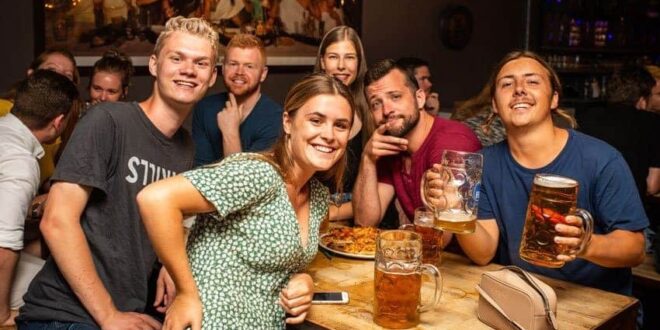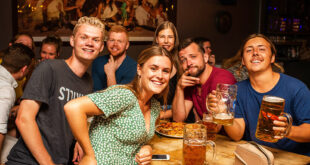Munich at night surprises people who arrive expecting only beer halls and oompah bands.
The real truth is simple and concrete: Munich’s nightlife today is a blend of two identities—its historic beer-drinking tradition and a fast-modernizing club scene driven by electronic music, international DJs, and stylish late-night crowds.
If you want a city where you can start your evening with a Maß of Helles in a 200-year-old tavern and end it dancing under LED strips at 4 AM, Munich is exactly that city.
The contrast is not accidental; it is what defines the Munich nightflow. And this blend of old and new shapes how people socialize, move through the city, choose venues, and build their entire night out.
1. The Foundation: Why Munich’s Beer Culture Still Shapes the Night
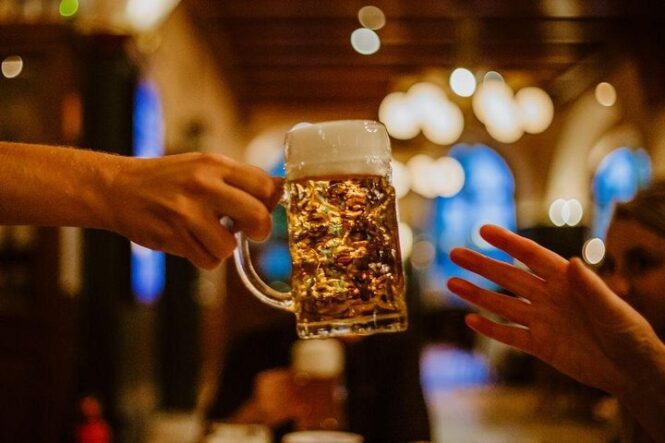
Beer is not just a drink in Munich; it is the social fabric. Even when people head to techno clubs after midnight, the tone of the night is set hours earlier around shared tables, loud conversations, and the warmth of Bavarian hospitality.
The beer rooms and outdoor gardens—with their wooden benches, brass bands, and giant pretzels—are the city’s natural pre-party stage.
The Big Influence
Beer culture determines three core nightflow rules:
- People gather early.
Munich locals rarely start their night after 10 PM. They begin with food and beer, slowly shifting toward bars. - Social groups stay together.
Large tables create a group-driven nightlife, which later spills into clubs as one collective movement. - Local beers affect pacing.
A liter of Helles is smooth but substantial. It shapes the rhythm: slower, friendlier, and with a clear progression toward the louder nightlife zones.
Table: Classic Beer Halls vs. Modern Beer Spots in Munich
| Style | Atmosphere | Best For | Typical Hours |
| Traditional beer hall | Loud, communal, historic | Group meet-ups & pre-night gatherings | Afternoon–midnight |
| Modern craft-beer bar | Minimalist, urban | Beer tasting & warm-up before clubs | 17:00–01:00 |
Even younger clubgoers who prefer techno still start their night in some type of beer environment. It’s simply part of the city’s DNA.
2. Transition Phase: Where Beer Meets Beats
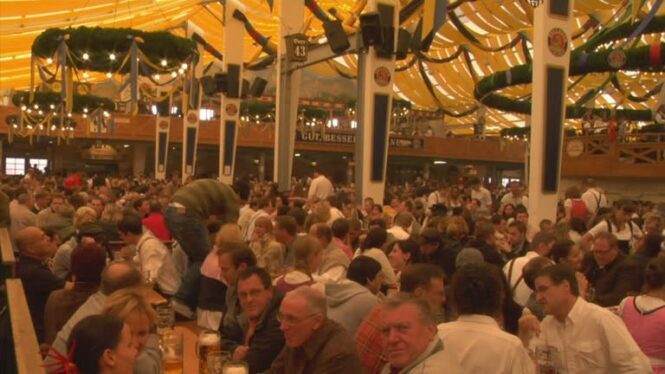
The shift from beer benches to dance floors doesn’t happen instantly. Munich has a strong “in-between” layer—cocktail bars, hybrid lounges, small DJ bars, and scattered music venues that serve as cultural bridges.
These places are ideal if you want to glide from the traditional into the modern without breaking the mood.
A typical Munich night begins near the Altstadt, moves toward Glockenbach or Maxvorstadt, and ends in the club zones of Kunstpark Ost, Kesselhaus, or Bahnwärter Thiel.
The walking distances are comfortable, and the flow feels almost designed.
Key Transitional Zones
Glockenbachviertel
Trendy, stylish, LGBTQ-friendly, full of bars that play soul, house, nu-disco, and deep lounge music. Many locals stop here before diving deeper into the night.
Maxvorstadt
Student energy, indie bars, and creative corners. Great for a more relaxed transition with craft cocktails and warm lighting.
Schwabing

Classic nightlife boulevard with a slightly older and more elegant crowd. Mature energy but still fun, and perfect if you prefer polished venues.
A Small Warm-Up Table
| Neighborhood | Vibe | Best Drink | Why It Works as a Transition |
| Glockenbach | Creative & stylish | House cocktails & spritz | Smooth jump toward house/techno clubs |
| Maxvorstadt | Young & diverse | Gins & longdrinks | Affordable, social, energetic |
| Schwabing | Elegant & polished | Wine & signature cocktails | Ideal for slower, more refined warm-ups |
In this transitional phase you start to feel Munich’s duality: relaxed beer culture staying in the background while modern nightlife rises.
3. The Club Flow: Munich’s Modern Dance Floors
Once midnight hits, Munich becomes a club city. The club scene is more curated than chaotic; Munich does not have Berlin’s edge, but it has precision, sound quality, and a crowd that knows exactly what it wants.
The city’s clubs range from industrial techno warehouses to funk-soul dance floors and Latin nights. What ties them together is a focus on atmosphere, lighting design, and strong DJ programs.
Types of Munich Clubs
- Techno/House Clubs
The backbone of Munich’s modern night identity. Expect deep, melodic, and minimal sets, clean sound systems, and industrial-inspired spaces. - Mixed-genre Dance Clubs
Perfect for groups who want R&B, hits, disco, and house in the same place. These venues attract a broader demographic. - Alternative & Cultural Clubs
Train cars, art installations, up-cycled venues. These places feel local and creative—ideal if you want something unexpected.
Club Energy Table
| Club Type | Music Style | Crowd | Best Time to Arrive |
| Techno warehouse | Techno, deep house | Late-night, stylish, electronic crowd | 00:30–02:00 |
| Mainstream club | Pop, R&B, charts | Mixed ages, international | 23:00–01:00 |
| Cultural/alt venue | Indie, electro, mixed genres | Artsy, local, creative | 22:00–00:00 |
This is the moment when Munich’s clean daytime image fades, replaced by lasers, underground rooms, and rhythms that carry people until sunrise.
4. The Social Layer: How People Move Through the Night

One of the most fascinating parts of Munich’s nightlife is how coordinated it feels. Groups move together, everyone knows the unwritten schedule, and encounters feel intentional rather than random.
Social Behavior Patterns
- People rarely club-hop aggressively.
- Groups grow during the night—friends invite more friends as they move.
- Most people avoid long waits; they choose venues where entry is efficient.
- The vibe is respectful, calm, and structured, but still energetic.
Munich has a polished social atmosphere. This is also why certain premium lifestyle services operate smoothly in the city.
For example, travelers who want company or a guided social experience sometimes rely on local agencies, and Munich’s nightlife districts openly cater to refined adult experiences.
It’s common to see references in upscale bars and lounges to curated companionship services, and in that context, the presence of an escort service München fits naturally into the city’s modern nightlife ecosystem—high-quality venues, adult audiences, and a culture that treats nightlife as something elegant rather than chaotic.
5. Late-Night Food, After-Hours, and the Final Descent
After the clubs, Munich has a quieter after-hours scene than Berlin, but it offers quality options that help close the night in a warm and pleasant way.
What Happens After 3 AM?
- People spill out toward street-food stands and bakeries.
- Some end the night with a late beer in small pubs.
- Others head toward the Isar riverbanks for fresh air.
- Taxis become the city’s bloodstream as people move toward hotels.
It’s a gentle landing—not messy, not overly loud, but human, warm, and social.
Late-Night Food Table
| Food Type | Where to Find It | Why It Works at 3–5 AM |
| Döner | Central stations & Isar area | Fast, filling, classic German nightlife food |
| Currywurst | Inner-city kiosks | Heavy enough to close the night |
| Sandwiches & pastries | 24h bakeries | Softer ending, lighter option |
Munich’s late-night energy is not chaotic; it feels almost structured, as if the city knows exactly how to guide you home.
6. How to Experience the Full Munich Nightflow (A Simple Blueprint)
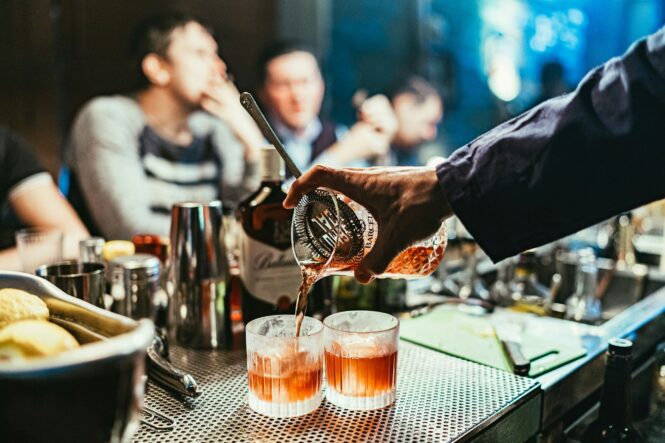
Here is the natural way most locals experience a night out. It’s not a strict rule—more like a cultural rhythm.
- Start early with beer and food.
Traditional hall or a modern beer bar. - Shift to a transitional bar.
Cocktails, warm lighting, music building slowly. - Move into the club zone around midnight.
One club per night usually works best. - Wind down with late food or a riverside walk.
The peaceful end is as much part of Munich’s identity as the party.
A Nightflow Snapshot Table
| Time | Typical Location | Vibe |
| 18:00–20:00 | Beer hall or garden | Social, warm, classic Munich |
| 20:30–23:00 | Cocktail bar / lounge | Stylish transition |
| 00:00–03:30 | Dance club | Modern Munich beats |
| 03:30–05:00 | Food stands & streets | Soft landing |
Conclusion
Munich’s nightflow is defined by contrast but also by connection. You begin in one of the most traditional beer cultures in the world and end in a sleek, globally influenced dance environment.
What makes Munich special is how seamless the journey feels. The city does not force you to choose between old and new; it gives you both, in a natural rhythm that feels almost choreographed.
 Imagup General Magazine 2025
Imagup General Magazine 2025
